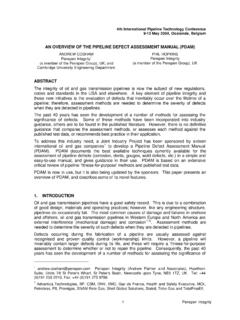Transcription of This document was downloaded from the Penspen Integrity ...
1 this document was downloaded from the Penspen Integrity virtual library For further information, contact Penspen Integrity : Penspen Integrity Units 7-8 St. Peter's Wharf Newcastle upon Tyne NE6 1TZ United Kingdom Telephone: +44 (0)191 238 2200 Fax: +44 (0)191 275 9786 Email: Website: 6th International Conference, Pipeline Rehabilitation and Maintenance, October 6-10, 2003, Hilton Berlin, Germany 1 Magnetic Flux Leakage Pigs or Ultrasonic Pigs? The Case for Combined Intelligent Pig Inspections Dr Andrew Pople Penspen Integrity Hawthorn Suite Units 7 & 8 St.
2 Peter s Wharf Newcastle upon Tyne NE6 1TZ UNITED KINGDOM this paper describes a case study where a pipeline operator was faced with features in the pipe wall that proved difficult to conclusively identify. An ultrasonic (UT) pig inspection indicated that the pipeline contained numerous deep external defects. However, subsequent excavations indicated that the reported external defects were in fact mainly laminations and/or inclusions. To verify that this was the case for the whole pipeline the operator ran both a magnetic flux leakage (MFL) and an ultrasonic inspection tool in the same inspection programme, using the magnetic flux leakage tool to confirm the absence of part-wall defects and hence demonstrating the presence of laminations.
3 6th International Conference, Pipeline Rehabilitation and Maintenance, October 6-10, 2003, Hilton Berlin, Germany A. Pople 2 Penspen Integrity Introduction Pipeline operators now have a wide choice of inline inspection tools (pigs) that have the capability to deliver a consistently high-level of reporting of pipeline features and defects. The two main internal inspection technologies are magnetic flux leakage (MFL) and ultrasonic (UT). Each has its benefits, however, each has its inherent limitations and neither can identify all possible pipeline defects.
4 A case study is described in this paper where a pipeline operator was faced with features in the pipe wall that proved difficult to conclusively identify. An internal ultrasonic pig inspection had indicated that the pipeline contained many deep external defects. However, subsequent excavation and external inspection of the pipeline for verification indicated that the reported features were not as serious as initially thought: the defects identified by the external examinations were not all external defects but were, in fact, mainly laminations and/or inclusions in the pipe wall.
5 The pipeline s operating conditions meant that laminations were not considered an Integrity issue for this pipeline1, whereas the reported external defects reported were. Consequently, the pipeline operator required a method of inspection that could conclusively identify the features in the pipeline, without any ambiguity regarding external features or laminations. After consultation with Penspen Integrity , the pipeline operator opted to run both a magnetic flux leakage pig and an ultrasonic pig in the same inspection.
6 The magnetic flux leakage tool used can detect metal-loss defects but not laminations. The ultrasonic tool used can accurately identify internal metal-loss, but can have difficulties when differentiating between external metal-loss and laminations. Consequently, the combined inspection can use the ultrasonic tool to identify the location of possible external metal-loss (or laminations) and the magnetic flux leakage tool can be used to confirm metal-loss, hence conclusively demonstrating where laminations are present in the pipeline.
7 When undertaking a pipeline Integrity assessment it is important to take a holistic approach and use all available data. It is important to understand the nature and cause of features in a pipeline and to understand the significance of those features. Therefore, this paper discusses the technologies available, the importance of correctly characterising pipeline defects and describes the circumstances where two or more different methods to inspect a pipeline are needed to remove ambiguous reporting of pipeline defects. It describes the technical challenges presented by the combined ultrasonic and magnetic flux leakage inspection and the benefits that the combined inspection has.
8 The paper briefly covers some of the project management issues that arise when using more than one pipeline inspection contractor. Finally, the paper describes the findings of the inspection programme. Intelligent Pig Inspection Intelligent pigs are used to provide information about the condition of a pipeline and can be used to locate problem areas. Intelligent pigs are either free flowing pigs, that are propelled by the fluid and are totally self-contained (onboard power, data collection, etc.), or they are tethered (or cable) pigs, that are connected to a power supply and/or data acquisition equipment via a cable.
9 The latter can either be driven by motors, or pumped through the pipeline and are particularly useful for unpiggable lines such as loading lines. 1 A lamination is an internal metal separation creating layers that are generally orientated parallel to the pipe wall. A lamination is a defect in the body of the pipe and is a material/manufacturing defect. The presence of a large number of laminations in a pipeline is indicative of dirty steel, possibly of poor quality.
10 However, laminations have not generally been regarded as a significant problem[1,2,3,4], except under particular circumstances[3], namely: (i) Laminations at an angle to the pipe wall can reduce the effective thickness of the pipe; (ii) Multiple laminations may present a leakage path; (iii) Hydrogen blisters can form as a result of the collection of molecular hydrogen in laminations or in clusters of inclusions in the pipe wall. The formation of hydrogen blisters is associated with sour corrosion.


